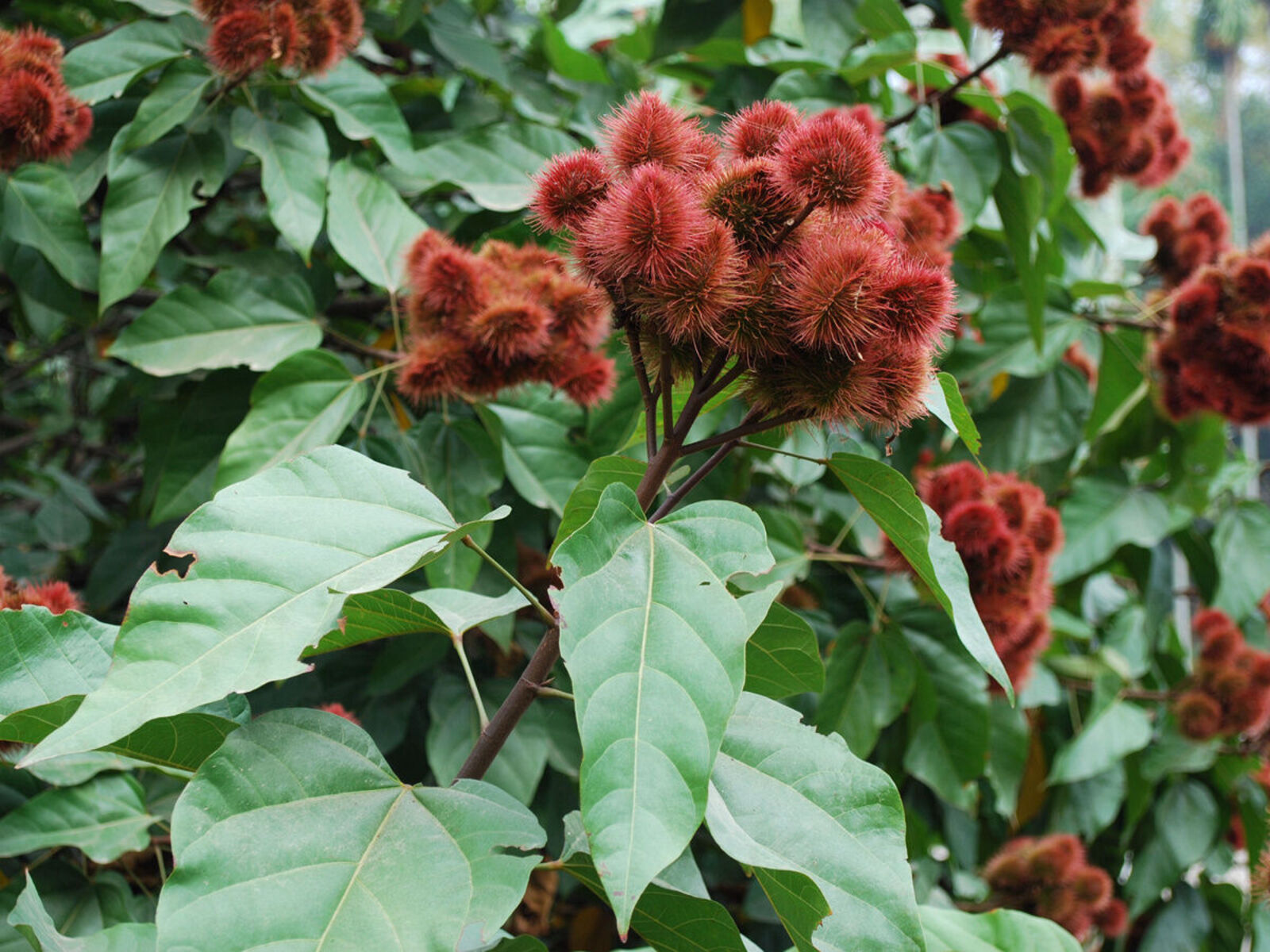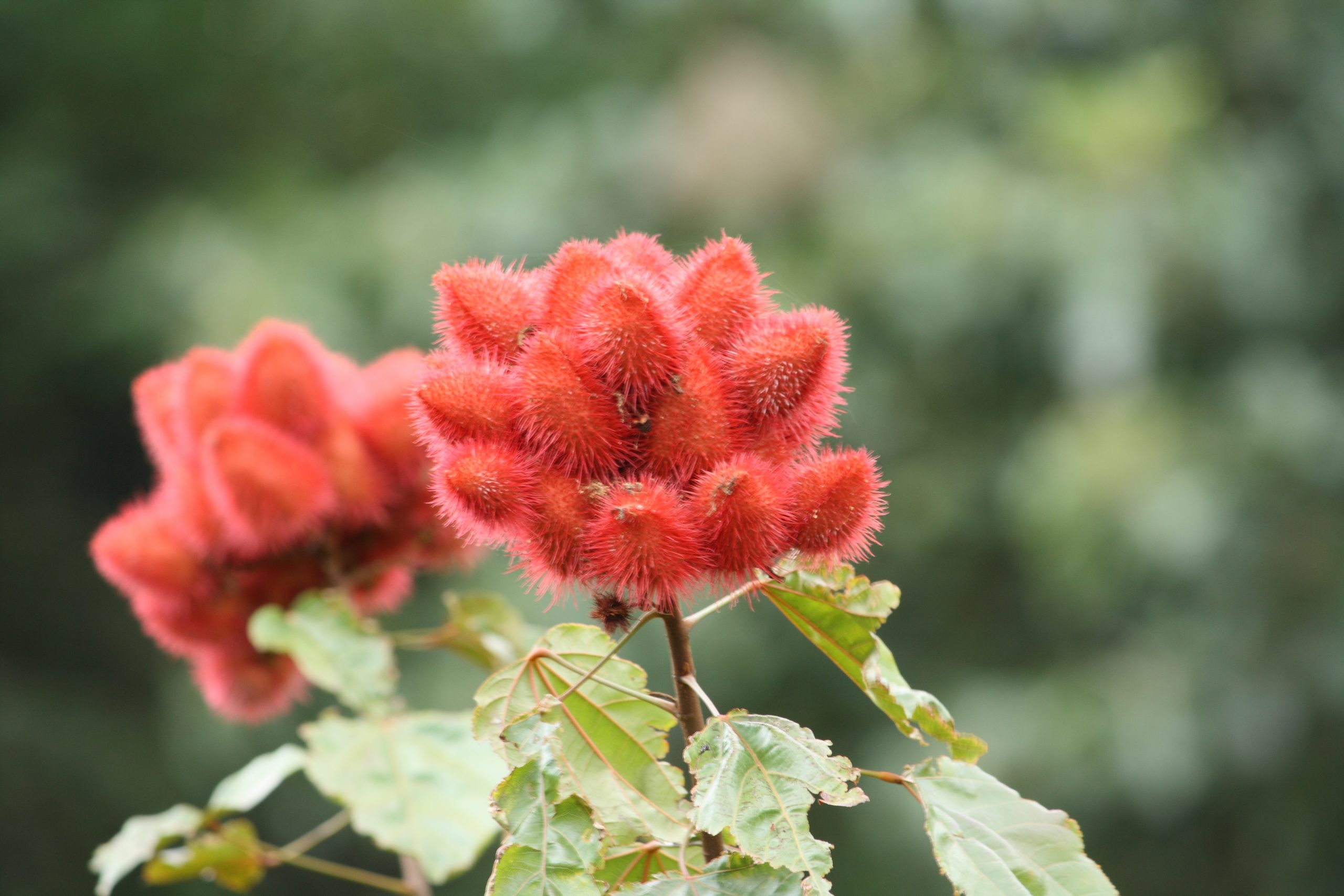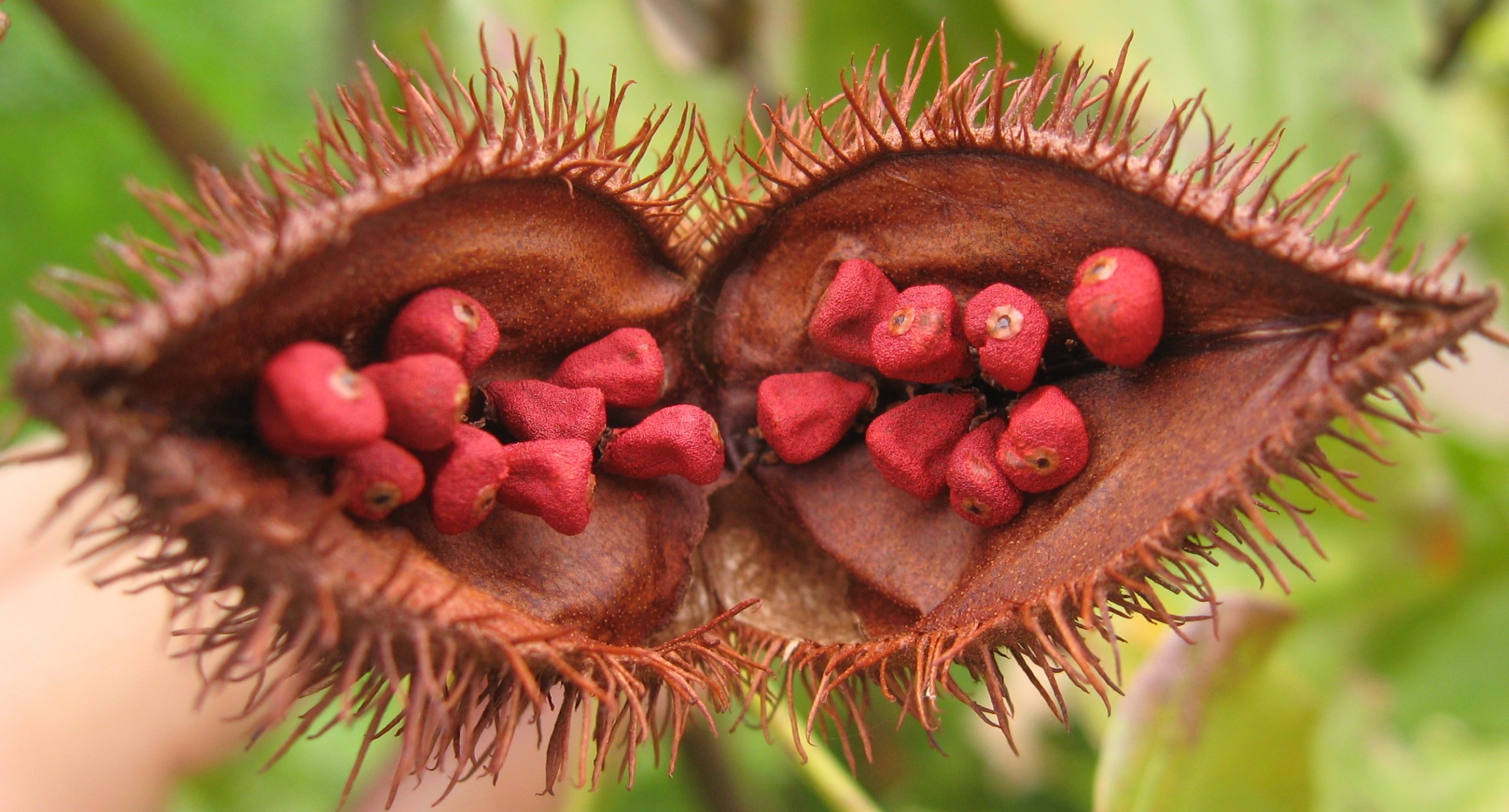Contents:
Common Names | Parts Usually Used | Plant(s) & Culture | Where Found | Medicinal Properties | Biochemical Information
Uses | Formulas or Dosages | How Sold | Warning | Resource Links
Scientific Names

- Bixa orellana L.
- Bixa orellana
Common Names
- Annatto
- Achiote
- Achiotillo
- Bija
- Urucum
- Atsuete
- Urucu
- Lipstick Tree
- Arnotta
- Orlean
- Rocou
- Santo-Domingo
- Onoto
- Analto
- Poor Man’s Saffron
Parts Usually Used
The seeds, leaves, and roots are used medicinally. The seeds are the primary part used, as they contain the highest concentration of active compounds including the natural dye and therapeutic substances.
Back to Top
Description of Plant(s) and Culture

Annatto is a small shrub or tree that grows 3-6 meters (10-20 feet) high, native to Central and South America. The trunk is short, measuring 20-30 cm in diameter, with dark gray bark featuring lenticels in vertical rows. The leaves are alternate, 10-20 cm long and 5-10 cm wide, sharp, and green on both sides with extended petioles.
The plant produces clusters of reddish-brown, heart-shaped fruit covered in soft, spiky bristles. Each fruit contains 10-50 small, reddish-orange seeds that measure 0.3-0.5 cm in length. The seeds are covered with a waxy outer coating that contains the valuable pigments and bioactive compounds. The number of seeds per capsule varies, with each bivalvar capsule containing 30-60 seeds on average.
Back to Top
Where Found

Annatto is native to Central and South America, specifically the Amazon region, but now grows in tropical and subtropical regions worldwide. It is cultivated in tropical countries including Peru, Mexico, Ecuador, Brazil, Indonesia, India, Kenya, East Africa, and the Caribbean. Latin America produces 60% of total world production, followed by Africa (27%) and Asia (12%). The main producers in Latin America are Peru, Brazil, and Mexico. Annual world production of achiote seeds is approximately 14,500 tons (dry weight).
Back to Top
Medicinal Properties
Annatto has been extensively studied and shown to possess numerous medicinal properties, including antioxidant, antimicrobial, anti-inflammatory, anticancer, hepatoprotective, cardioprotective, bone-protective, and neuroprotective effects.
The plant exhibits broad spectrum antibacterial activity against various pathogens including Bacillus subtilis, Staphylococcus aureus, Streptococcus pyogenes, Salmonella typhi, Pseudomonas aeruginosa, Escherichia coli, and Candida albicans. Research has demonstrated antifungal properties against Cryptococcus neoformans, Trichophyton mentagrophytes, and other fungal strains.
Studies have shown significant antioxidant activity through free radical scavenging, with annatto extracts providing protection against reactive oxygen species including hydrogen peroxide, hypochlorous acid, superoxide, nitric oxide, and peroxynitrite. The anti-inflammatory effects include reduction of histamine-induced paw edema, inhibition of cyclooxygenase enzymes (COX-1 and COX-2), and suppression of inflammatory markers.
Anticancer research has demonstrated cell proliferation inhibitory effects against colon, central nervous system, stomach, lung, prostate, liver, and blood cancer cell lines. The plant also shows promise for bone health, with studies indicating improved bone density, reduced bone resorption, and enhanced bone formation.
Back to Top
Biochemical Information
The primary bioactive compounds in annatto include:
- Carotenoids: Bixin (80% of pigments), norbixin, lutein, zeaxanthin, beta-carotene, cryptoxanthin, and methylbixin
- Tocotrienols: Delta-tocotrienol (>90%), beta-tocotrienol, and other vitamin E compounds
- Terpenoids: Farnesylacetone, geranylgeraniol, geranylgeranyl octadecanoate
- Sesquiterpenes: Beta-humulene, alpha-caryophyllene, alpha-copaene, spathulenol, ishwarane
- Flavonoids: Leucocyanidin, luteolin, apigenin, hypolaetin
- Phenolic acids: Ellagic acid, caffeic acid derivatives
- Other compounds: Tomentosic acid, phytol, stigmasterol, sitosterol
Bixin is the major carotenoid compound, accounting for up to 5% of seed content in high-quality varieties. The concentration can vary from less than 2% to over 5% depending on the cultivar and climatic conditions. Commercial value is based on bixin percentage, with levels higher than 2.5% usually required for export.
Back to Top
Uses
Annatto has been used traditionally across Central and South America for various medicinal purposes:
- Gastrointestinal disorders: Heartburn, diarrhea, stomach upset, constipation, dysentery
- Respiratory conditions: Bronchitis, cough, sore throat, asthma, pulmonary disorders
- Skin conditions: Burns, wounds, skin diseases, scabies, ulcers
- Infectious diseases: Malaria, measles, gonorrhea, hepatitis, urinary infections
- Metabolic disorders: Diabetes, fever reduction
- Women’s health: Labor pains, pregnancy-related issues
- Other uses: Snake bite treatment, insect repellent, sunscreen, body paint, aphrodisiac
Indigenous peoples have used different plant parts for specific conditions: seeds for antipyretic, cardiotonic, and antidiarrheal effects; leaves for snakebite treatment, gonorrhea, and respiratory disorders; and roots for diabetes, alcoholic hepatitis, and worm infestations.
Modern Applications
Current research has validated many traditional uses and identified new therapeutic applications:
- Metabolic syndrome: Studies show annatto tocotrienol improves glucose tolerance, insulin sensitivity, and lipid profiles
- Bone health: Tocotrienols preserve bone matrix, improve bone formation, and reduce bone resorption
- Eye health: Norbixin shows promise for treating age-related macular degeneration by reducing A2E accumulation
- Cancer therapy: Bixin demonstrates selective toxicity against multiple myeloma and other cancer cell lines
- Cardiovascular health: Compounds help lower cholesterol, reduce inflammation, and improve heart function
- Neurological conditions: Shows potential for preventing inflammatory neurological conditions
Formulas or Dosages
Research studies have used various dosages depending on the condition and extract type:
- For cholesterol reduction: 125-750 mg of annatto tocotrienol daily, with 250 mg showing significant effects after 4 weeks
- For bone health: 60-100 mg/kg of annatto tocotrienol in animal studies
- For diabetes management: 400-1600 mg tocotrienol per kg of diet in animal studies
- General supplementation: Studies suggest doses up to 750 mg daily for up to 12 months appear safe
- Food coloring use: Acceptable daily intake of 6 mg/kg body weight for bixin and 0.3 mg/kg for norbixin
The appropriate dose depends on factors such as age, health status, and specific conditions. Consult healthcare professionals before using annatto medicinally, as natural products are not always safe and proper dosages are important.
Back to Top
How Sold
Annatto is available in various commercial forms:
- Whole seeds (dried)
- Ground powder
- Paste (seeds combined with spices)
- Oil extracts
- Liquid extracts
- Standardized capsules and tablets
- Tocotrienol supplements
- Food coloring agents
- Essential oils
Warning
General Safety: Annatto seed extract is likely safe for most people when used in food amounts. Leaf powder is possibly safe when used at doses up to 750 mg daily for 12 months. There isn’t enough reliable information about safety when using larger medicinal amounts.
Allergic Reactions: Rarely, people sensitive to annatto may experience hives, swelling of the face, lips, or mouth, severe low blood pressure, or anaphylaxis. These reactions may occur due to traces of seed protein in annatto products.
Digestive Issues: Annatto may cause irritable bowel syndrome symptoms including abdominal pain, bloating, and diarrhea in susceptible individuals, though this is very rare.
Pregnancy and Breastfeeding: There isn’t enough reliable information about safety during pregnancy or breastfeeding. Pregnant and nursing women should avoid amounts larger than those typically found in food.
Diabetes: Annatto might increase or decrease blood sugar levels. People with diabetes should monitor blood sugar carefully when using annatto medicinally, as medication doses may need adjustment.
Surgery: Annatto might affect blood sugar levels, which could interfere with blood sugar control during and after surgery. Stop using annatto medicinally at least 2 weeks before scheduled surgery.
Drug Interactions: Annatto may interact with diabetes medications, potentially affecting their effectiveness or increasing the risk of low blood sugar. It may also increase how quickly the liver breaks down certain medications processed by cytochrome P450 1A1 enzymes.
Topical Use: There isn’t enough reliable information about the safety of applying annatto to the skin or using it in the eyes.
Back to Top
Resource Links
Sacred Herbs of the Amazon: What Shamans Know That Science is Just Discovering
Healthline – What Is Annatto? Uses, Benefits, and Side Effects
WebMD – Annatto – Uses, Side Effects, and More
Health – Health Benefits of Annatto (Bixa Orellana)
National Library of Medicine – Achiote (Bixa orellana L.): a natural source of pigment and vitamin E
National Library of Medicine – Carotenoids in human nutrition and health
